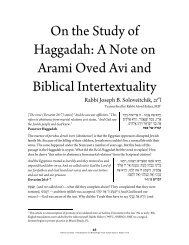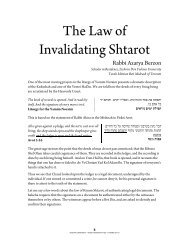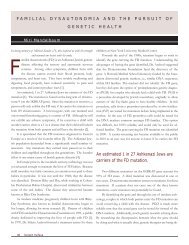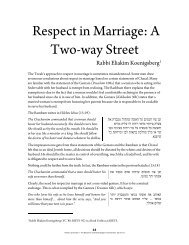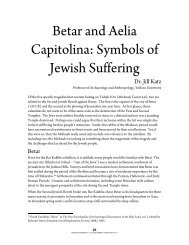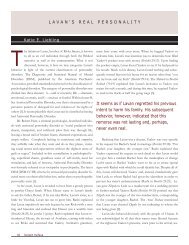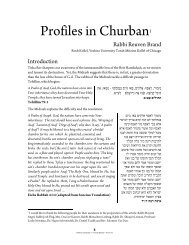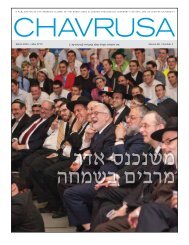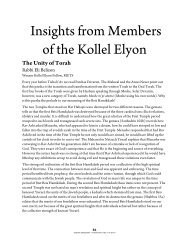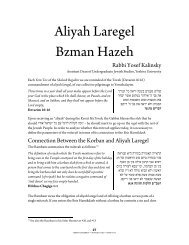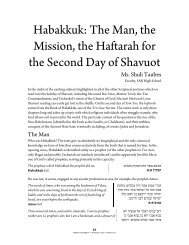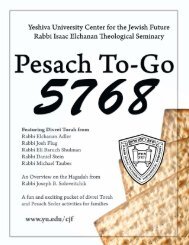YESHIVA UNIVERSITY • SUKKOT TO-GO ... - YU Torah Online
YESHIVA UNIVERSITY • SUKKOT TO-GO ... - YU Torah Online
YESHIVA UNIVERSITY • SUKKOT TO-GO ... - YU Torah Online
Create successful ePaper yourself
Turn your PDF publications into a flip-book with our unique Google optimized e-Paper software.
הריבעב האבה הוצמ applies to daled minim, it represents a form of hallel. Finally, the requirement<br />
that all daled minim be alive rather than desiccated and dead may also be based upon the need to<br />
utilize these species to recite a wordless hallel. Based upon a verse in Tehilim 115, the dead can<br />
[no longer] praise G-d, we can infer that only live species are viable for daled minim and for the<br />
hallel it induces. 65 These major halachot, along with more minor issues all underline the function<br />
of daled minim in assisting man to utter the unutterable - praise and glory for the King of kings.<br />
Recognizing the ineffectiveness of capturing the Almighty through human tongue we replace<br />
words with symbols from nature. As the Midrash Tanchuma notes - רעיה יצע וננרי זא Nature in<br />
all its glory exclaims the beauty and majesty of its Creator. 66 By seizing the choicest of these<br />
objects we harness that streaming praise and incorporate it into our Divine encounter. It is<br />
obvious that the quality of this praise is highly dependent upon the caliber of these minim.<br />
Selecting elegant and beautiful species assures that the current of our praise is both potent and<br />
eloquent.<br />
However, to fully appreciate the function of beauty and elegance within the mitzvah of daled<br />
minim a global view of Sukkot must be taken. Indeed, these qualities of beauty and style are vital<br />
to avodas Hashem in general and to hallel and praise in particular. Beyond these general<br />
functions though, beauty and splendor possess specific relevance to the holiday of Sukkot. The<br />
Midrash contrasts the hoisting of the daled minim and a very different “lifting” – a lifting<br />
performed once in history by an impoverished nation on the cusp of redemption. That first night<br />
in Egypt, on the verge of liberation, the still enslaved Jews selected simple reeds (בוזא תדוגא) and<br />
painted their doorposts with a very visible sign of faith. 67 Financially challenged, they could<br />
barely afford the splendor and elegance of daled minim and their mitzvah was capped at the<br />
more affordable level of reeds harvested from the banks of the Nile. The Midrash notes the<br />
impressive development of the Jewish people since those initial moments. With maturation and<br />
liberation came financial potency – the ability to upgrade their mitzvah performance with<br />
greater affluence and aesthetic. This financial maturity is “indexed” by the transformation of<br />
בוזא תחיקל to םכל םתחקלו! The elegance of the daled minim showcase the prosperity of the<br />
Jewish people and the rewards of being G-d’s chosen people. The splendor of these minim both<br />
celebrates our freedom and additionally provides a nostalgic recall of that magical night of faith,<br />
when we couldn’t afford the magnificence we currently display.<br />
In addition to announcing our newfound prosperity, the elegance of the daled minim serve as a<br />
triumphant coda to the awe and fury of the High Holidays. A very well known Midrash portrays<br />
a scene of several subjects emerging from court with each being handed a verdict. The victorious<br />
are identified by their swords raised to heaven in obvious demonstration of triumph. Similarly,<br />
the Midrash reasons, all of humanity is judged during the Days of Judgment. By raising the daled<br />
minim the Jewish people are expressing their confidence in their national vindication. The<br />
magnificence and regality of the daled minim clearly accentuates the sign of victory and national<br />
confidence. It is clear that a “pure” taking, unobstructed by intervening materials, indicates this<br />
65 Yerushalmi Succah (3:1)<br />
66 Vayikra Rabbah 30:4<br />
67 Vayikra Rabbah 30;1<br />
50<br />
<strong>YESHIVA</strong> <strong>UNIVERSITY</strong> <strong>•</strong> <strong>SUKKOT</strong> <strong>TO</strong>-<strong>GO</strong> <strong>•</strong> TISHREI 5771



